Java实现在线聊天
Posted 小影~
tags:
篇首语:本文由小常识网(cha138.com)小编为大家整理,主要介绍了Java实现在线聊天相关的知识,希望对你有一定的参考价值。
目录
📕 介绍
注:可以直接看整合java
t-io是基于java开发的一个开源的网络编程架构,大家都知道现在手机上或者电脑上都装了很多APP,这些APP都不是一个个在手机上或电脑上孤立的使用,而是能访问其他的地方数据或者与其他节点进行实时聊天,故每个APP中都要有一个对外进行通信的模块,这块内容从编程的角度来看就能通过网络编程框架来实现,t-io就是完成这块的内容的最好的编程软件。
t-io经过创始人谭先生的精心打磨,性能超强,已经达到运营的的级别,用t-io写的程序每秒能处理1000+万条消息,1.9G内存能够支撑30万TCP长连接。
基于tio开发的即时通讯软件谭聊,目前是业界性能最强的全开源销售即时通讯软件。
👍 特点
t-io是基于JVM的网络编程框架,和netty属同类,所以netty能做的t-io都能做,考虑到t-io是从项目抽象出来的框架,所以t-io提供了更多的和业务相关的API,大体上t-io具有如下特点和能力
- 内置完备的监控和流控能力
- 内置半包粘包处理
- 一骑绝尘的资源管理能力
- 内置心跳检查和心跳发送能力
- 内置IP拉黑
- 一流性能和稳定性(第三方权威平台TFB提供性能测试和稳定性服务)
- 极其稳定的表现(很多用户还是停在t-io 1.x版本,就是因为太过稳定,不想变动)
- 内置慢攻击防御
- 唯一一个内置异步发送、阻塞发送、同步发送的网络框架
- 唯一内置集群分发消息的能力
- 独创的多端口资源共享能力(譬如一个端口是websocket协议,一个端口是私有的im协议,这两个端口的资源可以共享,这对协议适配极其有用)
- 独创协议适配转换能力(让基于websocket和基于socket的应用看起来像是同一个协议)
- 独一档的资源和业务绑定能力:绑定group、绑定userid、绑定token、绑定bsId,这些绑定几乎囊括了所有业务需求
👏 t-io性能与对比
t-io测试结果:30W长连接并发压力,每秒1051万条聊天消息
netty和t-io对比:
- netty:100秒内生成10000个连接,每个连接每隔2秒发送一条消息,每个连接总共发送200条消息,发消息请求99%的响应时间在1ms以内,其它请求95%的响应时间在10ms以内

- t-io:100秒内生成10000个连接,每个连接每隔2秒发送一条消息,每个连接总共发送200条消息,发消息请求99%的响应时间在1ms以内

- CPU使用率:
- netty:CPU使用率在20%左右
- t-io:CPU使用率在15%左右
💌 使用介绍
🎁 业务数据绑定
资源绑定是指把业务相关的数据和Tcp连接(即ChannelContext)关联起来,譬如ChannelContext-A代表了用户张三,张三的userid是333
Tio.bindUser(ChannelContext-A, "333") t-io目前内置了4种资源绑定,譬如给group加前缀"ios- ",从而标记这个用户使用的是ios
Tio.bindGroup(ChannelContext-A, "333");
Tio.bindGroup(ChannelContext-A, "ios-" + "333");内置的4种资源绑定方法中,一个ChannelContext是可以绑定到多个groupid的,其它三个绑定都是一对一或多对一的关系,也就是说一个ChannelContext可以同时属于group-a,group-b… …group-n
/**
* 绑定业务id
* @param channelContext
* @param bsId
*/
public static void bindBsId(ChannelContext channelContext, String bsId)
channelContext.tioConfig.bsIds.bind(channelContext, bsId);
/**
* 绑定群组
* @param channelContext
* @param group
*/
public static void bindGroup(ChannelContext channelContext, String group)
channelContext.tioConfig.groups.bind(group, channelContext);
/**
* 绑定token
* @param channelContext
* @param token
*/
public static void bindToken(ChannelContext channelContext, String token)
channelContext.tioConfig.tokens.bind(token, channelContext);
/**
* 绑定用户
* @param channelContext
* @param userid
*/
public static void bindUser(ChannelContext channelContext, String userid)
channelContext.tioConfig.users.bind(userid, channelContext);
🤷♂️ 业务数据解绑
既然有绑定,就肯定会有解绑,这是个和绑定相反的操作
/**
* 解绑业务id
* @param channelContext
*/
public static void unbindBsId(ChannelContext channelContext)
channelContext.tioConfig.bsIds.unbind(channelContext);
/**
* 与所有组解除解绑关系
* @param channelContext
*/
public static void unbindGroup(ChannelContext channelContext)
channelContext.tioConfig.groups.unbind(channelContext);
/**
* 与指定组解除绑定关系
* @param group
* @param channelContext
*/
public static void unbindGroup(String group, ChannelContext channelContext)
channelContext.tioConfig.groups.unbind(group, channelContext);
/**
* 解除channelContext绑定的token
* @param channelContext
*/
public static void unbindToken(ChannelContext channelContext)
channelContext.tioConfig.tokens.unbind(channelContext);
// org.tio.core.TioConfig.ipBlacklist
/**
* 解除channelContext绑定的userid
* @param channelContext
*/
public static void unbindUser(ChannelContext channelContext)
channelContext.tioConfig.users.unbind(channelContext);
/**
* 解除userid的绑定。一般用于多地登录,踢掉前面登录的场景
* @param tioConfig
* @param userid
*/
public static void unbindUser(TioConfig tioConfig, String userid)
tioConfig.users.unbind(tioConfig, userid);
👀 异步发送
- 异步发送,指的是业务层把Packet丢给t-io后立即返回,返回时Packet并没有被发送,而只是提交到了待发送队列
- 异步发送都是以send开头的
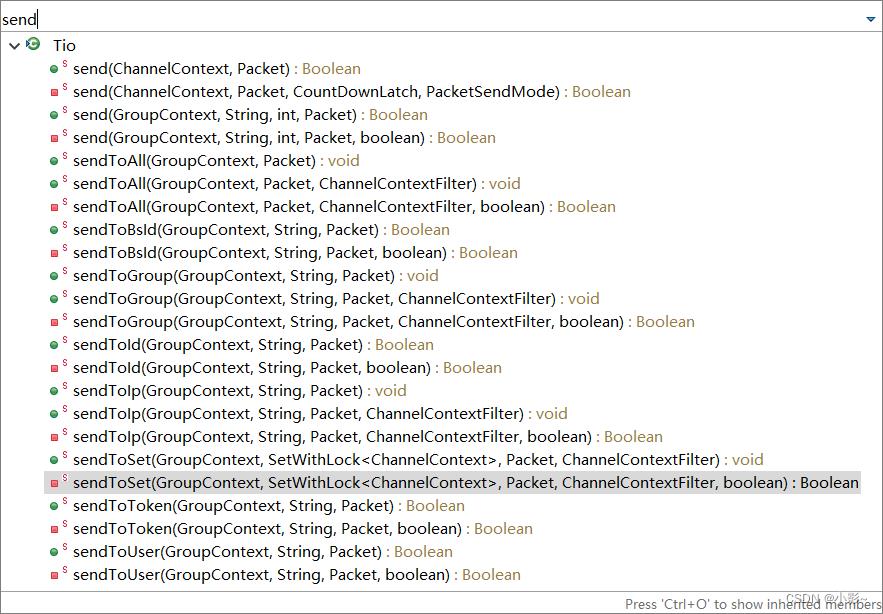
🐱👤 阻塞发送
- 阻塞发送:t-io把Packet送给对方后才返回
- 阻塞发送都是以bSend开头的
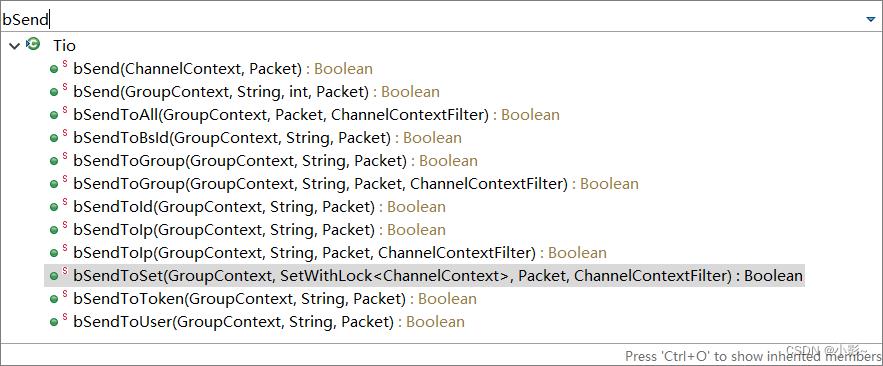
🙌 获取ChannelContext
- 前面的业务数据绑定,一个重要的目的就是要根据那些业务标识来获取ChannelContext,譬如你绑定了一个userid,那么后面就可以通过这个userid来获取ChannelContext
- 获取ChannelContext的API都是以get开头的
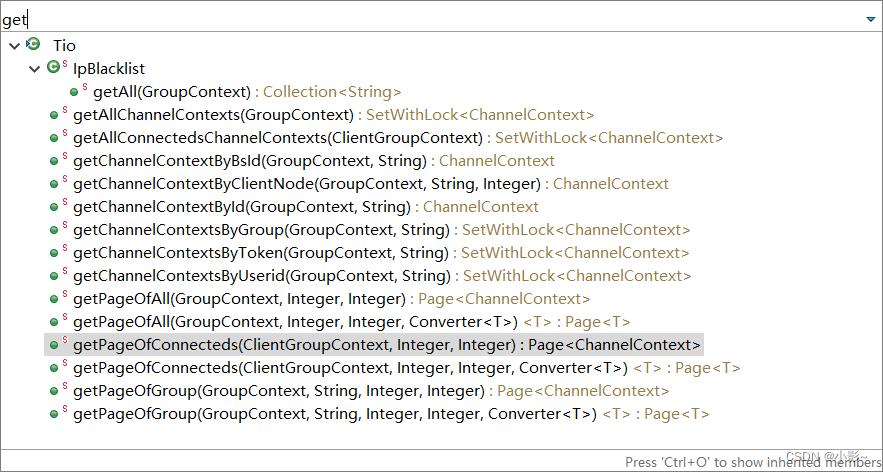
🐱👓 断开连接和移除连接
断开连接都是以close开头的方法,指的是把当前已经连上的TCP连接断开掉

移除连接都是以remove开头的方法,指的是彻底抛弃这个连接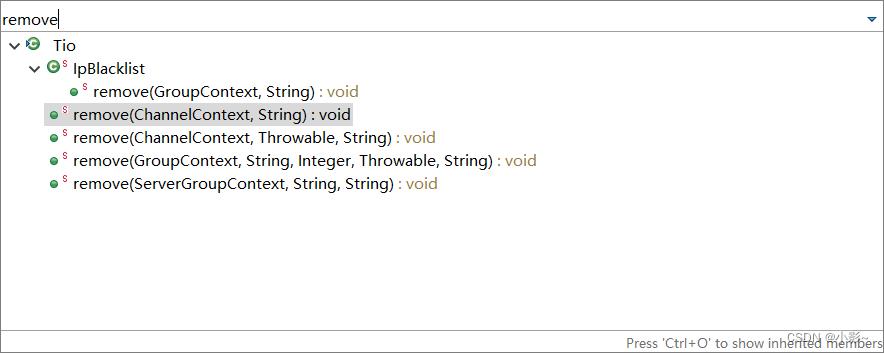
🚕Tio.remove()和Tio.close()的区别
Tio.remove:不管是用t-io做TCP服务器还是TCP客户端,调用Tio.remove()后,t-io都会彻底删除TCP连接并释放包括ChannelContext在内的所有和该条TCP连接对应的资源,当然那些和群组、Token的绑定关系也全部释放掉
Tio.close:
- 如果是用t-io做TCP服务器,此方法等价于Tio.remove();
- 如果是用t-io做TCP客户端
- 该方法会断开当前TCP连接
- 如果业务程序配置了重连策略(就是:ReconnConf):
- t-io后面会进行重连操作,也就是说并不会抛弃该条TCP连接对应的ChannelContext对象
- 如果该条TCP连接对应的ChannelContext对象绑定了groupid、userid、token、bsId,那么这些绑定关系会全部释放掉,在重连成功后,业务侧需要再次进行绑定
- 如果业务程序没有配置重连策略(就是:ReconnConf),此方法等价于Tio.remove()
出现网络异常或其它异常时,业务需要主动调用这俩方法吗?
答:不需要的,出现任何网络异常,t-io都会释放掉该条TCP连接对应的全部资源,这也是t-io如此稳定的一大原因。网络编程的很多坑,都是源于资源没释放
🏴 拉黑IP
简单到极致,只需要一行代码
Tio.IpBlacklist.add(tioConfig, channelContext.getClientNode().getIp());🚨 各种流量监控
🛴 ip的监控数据
ip的监控数据定义在IpStat中
private Date start = new Date();
/**
* 当前统计了多久,单位:毫秒
*/
private long duration;
/**
* 时长类型,单位:秒,譬如60,3600等
*/
private Long durationType;
/**
* 客户端ip
*/
private String ip;
/**
* 解码异常的次数
*/
private AtomicInteger decodeErrorCount = new AtomicInteger();
/**
* 收到该IP连接请求的次数
*/
private AtomicInteger requestCount = new AtomicInteger();
/**
* 本IP已发送的字节数
*/
private AtomicLong sentBytes = new AtomicLong();
/**
* 本IP已发送的packet数
*/
private AtomicLong sentPackets = new AtomicLong();
/**
* 本IP已处理的字节数
*/
private AtomicLong handledBytes = new AtomicLong();
/**
* 本IP已处理的packet数
*/
private AtomicLong handledPackets = new AtomicLong();
/**
* 处理消息包耗时,单位:毫秒
*/
private AtomicLong handledPacketCosts = new AtomicLong();
/**
* 本IP已接收的字节数
*/
private AtomicLong receivedBytes = new AtomicLong();
/**
* 本IP已接收了多少次TCP数据包
*/
private AtomicLong receivedTcps = new AtomicLong();
/**
* 本IP已接收的packet数
*/
private AtomicLong receivedPackets = new AtomicLong();使用步骤
- 实现IpStatListener
package org.tio.showcase.websocket.server;
public class ShowcaseIpStatListener implements IpStatListener
@SuppressWarnings("unused")
private static Logger log = LoggerFactory.getLogger(ShowcaseIpStatListener.class);
public static final ShowcaseIpStatListener me = new ShowcaseIpStatListener();
private ShowcaseIpStatListener()
@Override
public void onExpired(TioConfig tioConfig, IpStat ipStat)
//在这里把统计数据入库中或日志
// if (log.isInfoEnabled())
// log.info("可以把统计数据入库\\r\\n", Json.toFormatedJson(ipStat));
//
@Override
public void onAfterConnected(ChannelContext channelContext, boolean isConnected, boolean isReconnect, IpStat ipStat) throws Exception
// if (log.isInfoEnabled())
// log.info("onAfterConnected\\r\\n", Json.toFormatedJson(ipStat));
//
@Override
public void onDecodeError(ChannelContext channelContext, IpStat ipStat)
// if (log.isInfoEnabled())
// log.info("onDecodeError\\r\\n", Json.toFormatedJson(ipStat));
//
@Override
public void onAfterSent(ChannelContext channelContext, Packet packet, boolean isSentSuccess, IpStat ipStat) throws Exception
// if (log.isInfoEnabled())
// log.info("onAfterSent\\r\\n\\r\\n", packet.logstr(), Json.toFormatedJson(ipStat));
//
@Override
public void onAfterDecoded(ChannelContext channelContext, Packet packet, int packetSize, IpStat ipStat) throws Exception
// if (log.isInfoEnabled())
// log.info("onAfterDecoded\\r\\n\\r\\n", packet.logstr(), Json.toFormatedJson(ipStat));
//
@Override
public void onAfterReceivedBytes(ChannelContext channelContext, int receivedBytes, IpStat ipStat) throws Exception
// if (log.isInfoEnabled())
// log.info("onAfterReceivedBytes\\r\\n", Json.toFormatedJson(ipStat));
//
@Override
public void onAfterHandled(ChannelContext channelContext, Packet packet, IpStat ipStat, long cost) throws Exception
// if (log.isInfoEnabled())
// log.info("onAfterHandled\\r\\n\\r\\n", packet.logstr(), Json.toFormatedJson(ipStat));
//
- 初始化时添加监听器和监控时段
//注意的是:要保证下面两行代码的顺序,不能先addDuration()后setIpStatListener
serverTioConfig.setIpStatListener(ShowcaseIpStatListener.me);
serverTioConfig.ipStats.addDuration(Time.MINUTE_1 * 5);- OK了,什么时候拉黑IP以及把监控数据入库都在ShowcaseIpStatListener中实现哦
👀 获取TCP会话的流量数据
一个TCP会话对应一个ChannelContext对象,每个ChannelContext对象都有一个ChannelStat对象,定义如下
public final ChannelStat stat = new ChannelStat();ChannelStat包含如下字段和方法(已经略过普通的getter和setter)
/**
* 本次解码失败的次数
*/
public int decodeFailCount = 0;
/**
* 最近一次收到业务消息包的时间(一个完整的业务消息包,一部分消息不算)
*/
public long latestTimeOfReceivedPacket = SystemTimer.currTime;
/**
* 最近一次发送业务消息包的时间(一个完整的业务消息包,一部分消息不算)
*/
public long latestTimeOfSentPacket = SystemTimer.currTime;
/**
* 最近一次收到业务消息包的时间:收到字节就算
*/
public long latestTimeOfReceivedByte = SystemTimer.currTime;
/**
* 最近一次发送业务消息包的时间:发送字节就算
*/
public long latestTimeOfSentByte = SystemTimer.currTime;
/**
* ChannelContext对象创建的时间
*/
public long timeCreated = SystemTimer.currTime;
/**
* 第一次连接成功的时间
*/
public Long timeFirstConnected = null;
/**
* 连接关闭的时间
*/
public long timeClosed = SystemTimer.currTime;
/**
* 进入重连队列时间
*/
public long timeInReconnQueue = SystemTimer.currTime;
/**
* 本连接已发送的字节数
*/
public final AtomicLong sentBytes = new AtomicLong();
/**
* 本连接已发送的packet数
*/
public final AtomicLong sentPackets = new AtomicLong();
/**
* 本连接已处理的字节数
*/
public final AtomicLong handledBytes = new AtomicLong();
/**
* 本连接已处理的packet数
*/
public final AtomicLong handledPackets = new AtomicLong();
/**
* 处理消息包耗时,单位:毫秒
* 拿这个值除以handledPackets,就是处理每个消息包的平均耗时
*/
public final AtomicLong handledPacketCosts = new AtomicLong();
/**
* 本连接已接收的字节数
*/
public final AtomicLong receivedBytes = new AtomicLong();
/**
* 本连接已接收了多少次TCP数据包
*/
public final AtomicLong receivedTcps = new AtomicLong();
/**
* 本连接已接收的packet数
*/
public final AtomicLong receivedPackets = new AtomicLong();
/**
* 平均每次TCP接收到的字节数,这个可以用来监控慢攻击,配置PacketsPerTcpReceive定位慢攻击
*/
public double getBytesPerTcpReceive()
if (receivedTcps.get() == 0)
return 0;
double ret = (double) receivedBytes.get() / (double) receivedTcps.get();
return ret;
/**
* 平均每次TCP接收到的业务包数,这个可以用来监控慢攻击,此值越小越有攻击嫌疑
*/
public double getPacketsPerTcpReceive()
if (receivedTcps.get() == 0)
return 0;
double ret = (double) receivedPackets.get() / (double) receivedTcps.get();
return ret;
/**
* 处理packet平均耗时,单位:毫秒
* @return
*/
public double getHandledCostsPerPacket()
if (handledPackets.get() > 0)
return handledPacketCosts.get() / handledPackets.get();
return 0;
🐱🚀 监听端口的流量和数据
TioConfig对象有个GroupStat成员,定义如下
public GroupStat groupStat = null;GroupStat有如下一些字段和方法(去掉了简单的getter和setter)
/**
* 关闭了多少连接
*/
public final AtomicLong closed = new AtomicLong();
/**
* 接收到的消息包
*/
public final AtomicLong receivedPackets = new AtomicLong();
/**
* 接收到的消息字节数
*/
public final AtomicLong receivedBytes = new AtomicLong();
/**
* 处理了的消息包数
*/
public final AtomicLong handledPackets = new AtomicLong();
/**
* 处理消息包耗时,单位:毫秒
*/
public final AtomicLong handledPacketCosts = new AtomicLong();
/**
* 处理了多少字节
*/
public final AtomicLong handledBytes = new AtomicLong();
/**
* 发送了的消息包数
*/
public final AtomicLong sentPackets = new AtomicLong();
/**
* 发送了的字节数
*/
public final AtomicLong sentBytes = new AtomicLong();
/**
* 本IP已接收了多少次TCP数据包
*/
public final AtomicLong receivedTcps = new AtomicLong();
/**
* 平均每次TCP接收到的字节数,这个可以用来监控慢攻击,配置PacketsPerTcpReceive定位慢攻击
*/
public double getBytesPerTcpReceive()
if (receivedTcps.get() == 0)
return 0;
double ret = (double) receivedBytes.get() / (double) receivedTcps.get();
return ret;
/**
* 平均每次TCP接收到的业务包数,这个可以用来监控慢攻击,此值越小越有攻击嫌疑
*/
public double getPacketsPerTcpReceive()
if (receivedTcps.get() == 0)
return 0;
double ret = (double) receivedPackets.get() / (double) receivedTcps.get();
return ret;
/**
* 处理packet平均耗时,单位:毫秒
* @return
*/
public double getHandledCostsPerPacket()
if (handledPackets.get() > 0)
return handledPacketCosts.get() / handledPackets.get();
return 0;
对于服务器端的groupStat,它是在ServerTioConfig类中的初始化代码在构造函数中,如下
this.groupStat = new ServerGroupStat();对于客户端的groupStat,它是在ClientTioConfig类中的初始化代码在构造函数中,如下
this.groupStat = new ClientGroupStat();获取GroupStat
GroupStat groupStat = tioConfig.groupStat;
//如果确认是服务器端,则可以用强转方式获得ServerGroupStat对象
ServerGroupStat serverGroupStat = (ServerGroupStat)tioConfig.groupStat;
//如果确认是客户端,则可以用强转方式获得ClientGroupStat对象
ClientGroupStat clientGroupStat = (ClientGroupStat)tioConfig.groupStat;✨ T-io收发消息过程
Packet是用于表述业务数据结构的,我们通过继承Packet来实现自己的业务数据结构,对于各位而言,把Packet看作是一个普通的VO对象即可。
注意:不建议直接使用Packet对象,而是要继承Packet
🤣 TCP连接上下文
每一个tcp连接的建立都会产生一个ChannelContext对象,这是个抽象类,如果你是用t-io作tcp客户端,那么就是ClientChannelContext,如果你是用tio作tcp服务器,那么就是ServerChannelContext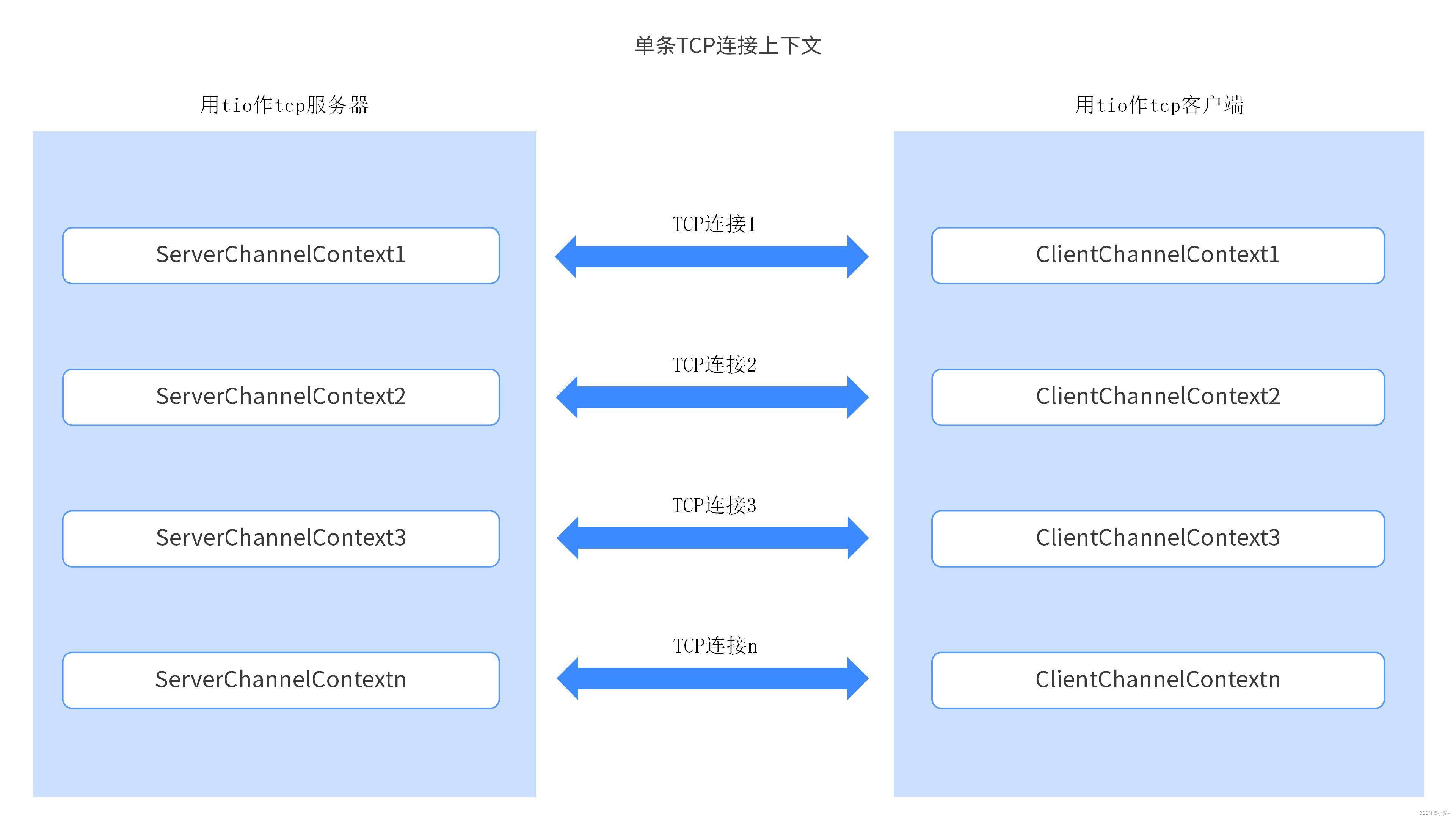
用户可以把业务数据通过ChannelContext对象和TCP连接关联起来,像下面这样设置属性
ChannelContext.set(String key, Object value)然后用下面的方式获取属性
ChannelContext.get(String key)当然最最常用的还是用t-io提供的强到没对手的bind功能,譬如用下面的代码绑定userid
Tio.bindUser(ChannelContext channelContext, String userid)然后可以通过userid进行操作,示范代码如下
//获取某用户的ChannelContext集合
SetWithLock<ChannelContext> set = Tio.getChannelContextsByUserid(tioConfig, userid);
//给某用户发消息
Tio.sendToUser(TioConfig, userid, Packet)除了可以绑定userid,t-io还内置了如下绑定API
- 绑定业务id
Tio.bindBsId(ChannelContext channelContext, String bsId)- 绑定token
Tio.bindToken(ChannelContext channelContext, String token)- 绑定群组
Tio.bindGroup(ChannelContext channelContext, String group)ChannelContext对象包含的信息非常多,主要对象见下图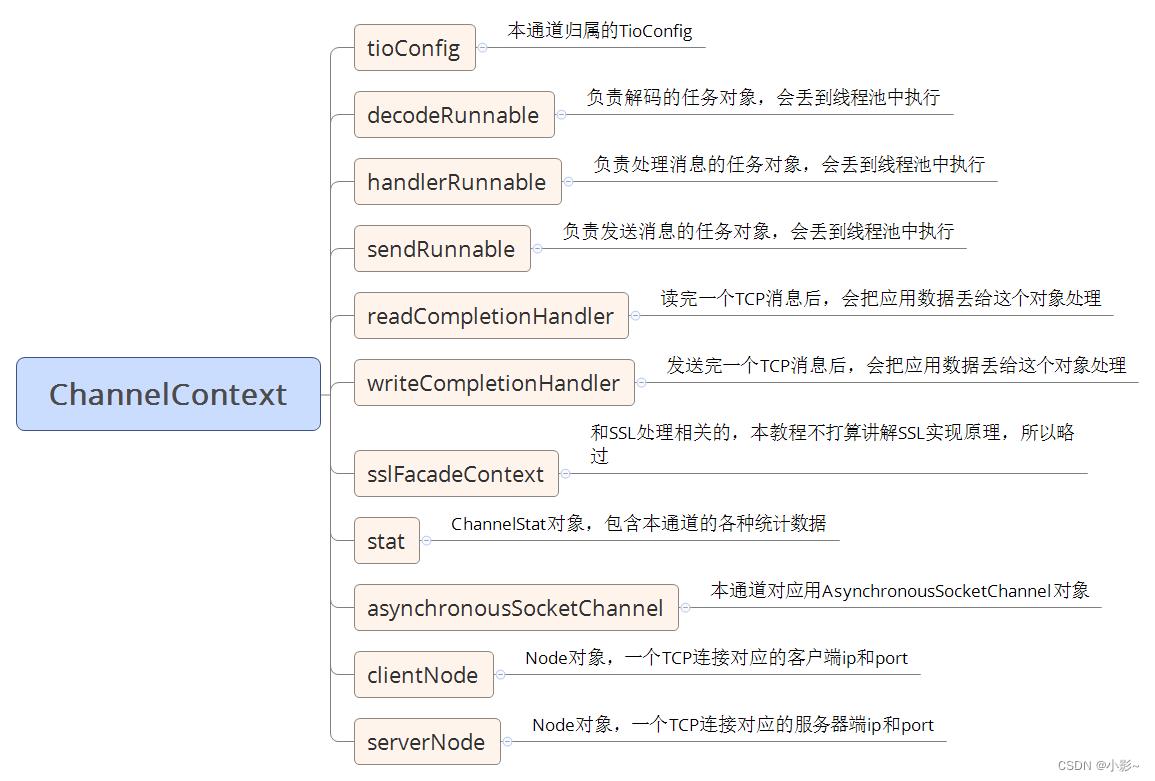
ChannelContext是t-io中非常重要的类,他是业务和连接的沟通桥梁!
📕 TioConfig
- 场景:我们在写TCP Server时,都会先选好一个端口以监听客户端连接,再创建N组线程池来执行相关的任务,譬如发送消息、解码数据包、处理数据包等任务,还要维护客户端连接的各种数据,为了和业务互动,还要把这些客户端连接和各种业务数据绑定起来,譬如把某个客户端绑定到一个群组,绑定到一个userid,绑定到一个token等。
- TioConfig
就是解决以上场景的:配置线程池、监听端口,维护客户端各种数据等的。
- TioConfig是个抽象类
- 如果你是用tio作tcp客户端,那么你需要创建ClientTioConfig对象
- 服务器端对应一个ClientTioConfig对象
- 如果你是用tio作tcp服务器,那么你需要创建ServerTioConfig
- 一个监听端口对应一个ServerTioConfig ,一个jvm可以监听多个端口,所以一个jvm可以有多个ServerTioConfig对象
- 如果你是用tio作tcp客户端,那么你需要创建ClientTioConfig对象
😀 消息来往监听
TioListener是处理消息的核心接口,它有两个子接口:TioClientListener和TioServerListener
- 当用tio作tcp客户端时需要实现TioClientListener
- 当用tio作tcp服务器时需要实现TioServerListener
它主要定义了如下方法
public interface TioListener
/**
* 建链后触发本方法,注:建链不一定成功,需要关注参数isConnected
*
* @param channelContext
* @param isConnected 是否连接成功,true:表示连接成功,false:表示连接失败
* @param isReconnect 是否是重连, true: 表示这是重新连接,false: 表示这是第一次连接
* @throws Exception
*/
public void onAfterConnected(ChannelContext channelContext, boolean isConnected, boolean isReconnect) throws Exception;
/**
* 原方法名:onAfterDecoded 解码成功后触发本方法
*
* @param channelContext
* @param packet
* @param packetSize
* @throws Exception
*/
public void onAfterDecoded(ChannelContext channelContext, Packet packet, int packetSize) throws Exception;
/**
* 处理一个消息包后
*
* @param channelContext
* @param packet
* @param cost 本次处理消息耗时,单位:毫秒
* @throws Exception
*/
public void onAfterHandled(ChannelContext channelContext, Packet packet, long cost) throws Exception;
/**
* 接收到TCP层传过来的数据后
*
* @param channelContext
* @param receivedBytes 本次接收了多少字节
* @throws Exception
*/
public void onAfterReceivedBytes(ChannelContext channelContext, int receivedBytes) throws Exception;
/**
* 消息包发送之后触发本方法
*
* @param channelContext
* @param packet
* @param isSentSuccess true:发送成功,false:发送失败
* @throws Exception */
public void onAfterSent(ChannelContext channelContext, Packet packet, boolean isSentSuccess) throws Exception;
/**
* 连接关闭前触发本方法
*
* @param channelContext the channelcontext
* @param throwable the throwable 有可能为空
* @param remark the remark 有可能为空
* @param isRemove
* @throws Exception
*/
public void onBeforeClose(ChannelContext channelContext, Throwable throwable, String remark, boolean isRemove) throws Exception;
/**
* 连接关闭前后触发本方法 警告:走到这个里面时,很多绑定的业务都已经解绑了,所以这个方法一般是空着不实现的
*
* @param channelContext the channelcontext
* @param throwable the throwable 有可能为空
* @param remark the remark 有可能为空
* @param isRemove 是否是删除
* @throws Exception
*/
// public void onAfterClose(ChannelContext channelContext, Throwable throwable,
// String remark, boolean isRemove) throws Exception;
🥰 整合JAVA
<!-- tio-websocket -->
<dependency>
<groupId>org.t-io</groupId>
<artifactId>tio-websocket-server</artifactId>
<version>3.5.9.v20200214-RELEASE</version>
</dependency>注意:每个版本之前存在差异请查看官方文档
🍔 websocket 配置类
import com.asurplus.tio.websocket.handle.MyWsMsgHandler;
import org.springframework.beans.factory.annotation.Autowired;
import org.springframework.context.annotation.Bean;
import org.springframework.context.annotation.Configuration;
import org.tio.server.ServerTioConfig;
import org.tio.websocket.server.WsServerStarter;
import java.io.IOException;
/**
* websocket 配置类
*/
@Configuration
public class WebSocketConfig
/**
* 注入消息处理器
*/
@Autowired
private MyWsMsgHandler myWsMsgHandler;
/**
* 启动类配置
*
* @return
* @throws IOException
*/
@Bean
public WsServerStarter wsServerStarter() throws IOException
// 设置处理器
WsServerStarter wsServerStarter = new WsServerStarter(6789, myWsMsgHandler);
// 获取到ServerTioConfig
ServerTioConfig serverTioConfig = wsServerStarter.getServerTioConfig();
// 设置心跳超时时间,默认:1000 * 120
serverTioConfig.setHeartbeatTimeout(1000 * 120);
// 启动
wsServerStarter.start();
return wsServerStarter;
这里我们注入了 WsServerStarter 的 bean,这样在 SpringBoot 启动的时候,就能启动咱们的 websocket 服务
- 注明了 websocket 的服务端口为:6789
- 消息处理类为:myWsMsgHandler,在下一步我们将会去实现这个类
- 设置了心跳的超时时间为:120秒,默认值,可以不设置
😄 消息处理类
package com.ying.tiiochat.config;
import com.alibaba.fastjson.JSONObject;
import org.springframework.stereotype.Component;
import org.tio.core.ChannelContext;
import org.tio.core.Tio;
import org.tio.http.common.HttpRequest;
import org.tio.http.common.HttpResponse;
import org.tio.websocket.common.WsRequest;
import org.tio.websocket.common.WsResponse;
import org.tio.websocket.server.handler.IWsMsgHandler;
/**
* 消息处理类
*/
@Component
public class MyWsMsgHandler implements IWsMsgHandler
/**
* <li>对httpResponse参数进行补充并返回,如果返回null表示不想和对方建立连接,框架会断开连接,如果返回非null,框架会把这个对象发送给对方</li>
* <li>注:请不要在这个方法中向对方发送任何消息,因为这个时候握手还没完成,发消息会导致协议交互失败。</li>
* <li>对于大部分业务,该方法只需要一行代码:return httpResponse;</li>
*
* @param httpRequest
* @param httpResponse
* @param channelContext
* @return
* @throws Exception
*/
@Override
public HttpResponse handshake(HttpRequest httpRequest, HttpResponse httpResponse, ChannelContext channelContext) throws Exception
// 可以在此做一些业务逻辑,返回null表示不想连接
return httpResponse;
/**
* 握手成功后触发该方法
*
* @param httpRequest
* @param httpResponse
* @param channelContext
* @throws Exception
*/
@Override
public void onAfterHandshaked(HttpRequest httpRequest, HttpResponse httpResponse, ChannelContext channelContext) throws Exception
// 拿到用户id
String id = httpRequest.getParam("userId");
// 绑定用户
Tio.bindUser(channelContext, id);
// 给用户发送消息
JSONObject message = new JSONObject();
message.put("msg", "连接成功...");
message.put("sendName", "系统提醒");
WsResponse wsResponse = WsResponse.fromText(message.toString(), "UTF-8");
Tio.sendToUser(channelContext.tioConfig, id, wsResponse);
/**
* <li>当收到Opcode.BINARY消息时,执行该方法。也就是说如何你的ws是基于BINARY传输的,就会走到这个方法</li>
*
* @param wsRequest
* @param bytes
* @param channelContext
* @return 可以是WsResponse、byte[]、ByteBuffer、String或null,如果是null,框架不会回消息
* @throws Exception
*/
@Override
public Object onBytes(WsRequest wsRequest, byte[] bytes, ChannelContext channelContext) throws Exception
System.out.println("我走了onBytes");
return null;
/**
* 当收到Opcode.CLOSE时,执行该方法,业务层在该方法中一般不需要写什么逻辑,空着就好
*
* @param wsRequest
* @param bytes
* @param channelContext
* @return 可以是WsResponse、byte[]、ByteBuffer、String或null,如果是null,框架不会回消息
* @throws Exception
*/
@Override
public Object onClose(WsRequest wsRequest, byte[] bytes, ChannelContext channelContext) throws Exception
// 关闭连接
Tio.remove(channelContext, "WebSocket Close");
return null;
/**
* <li>当收到Opcode.TEXT消息时,执行该方法。也就是说如何你的ws是基于TEXT传输的,就会走到这个方法</li>
*
* @param wsRequest
* @param text
* @param channelContext
* @return 可以是WsResponse、byte[]、ByteBuffer、String或null,如果是null,框架不会回消息
* @throws Exception
*/
@Override
public Object onText(WsRequest wsRequest, String text, ChannelContext channelContext) throws Exception
JSONObject message = JSONObject.parseObject(text);
// 接收消息的用户ID
String receiver = message.getString("receiver");
// 发送消息者
String sendName = message.getString("sendName");
// 消息
String msg = message.getString("msg");
// 保存聊天记录到DB等业务逻辑...
WsResponse wsResponse = WsResponse.fromText(message.toString(), "UTF-8");
Tio.sendToUser(channelContext.tioConfig, receiver, wsResponse);
JSONObject resp = new JSONObject();
resp.put("sendName", "系统提醒");
resp.put("msg", "发送成功");
return resp.toString();
我们实现了 IWsMsgHandler 接口,并重写了该接口的 5 个方法,这 5 个方法从 发送握手包,到消息收发,到断开连接等一系列过程
🚙 启动服务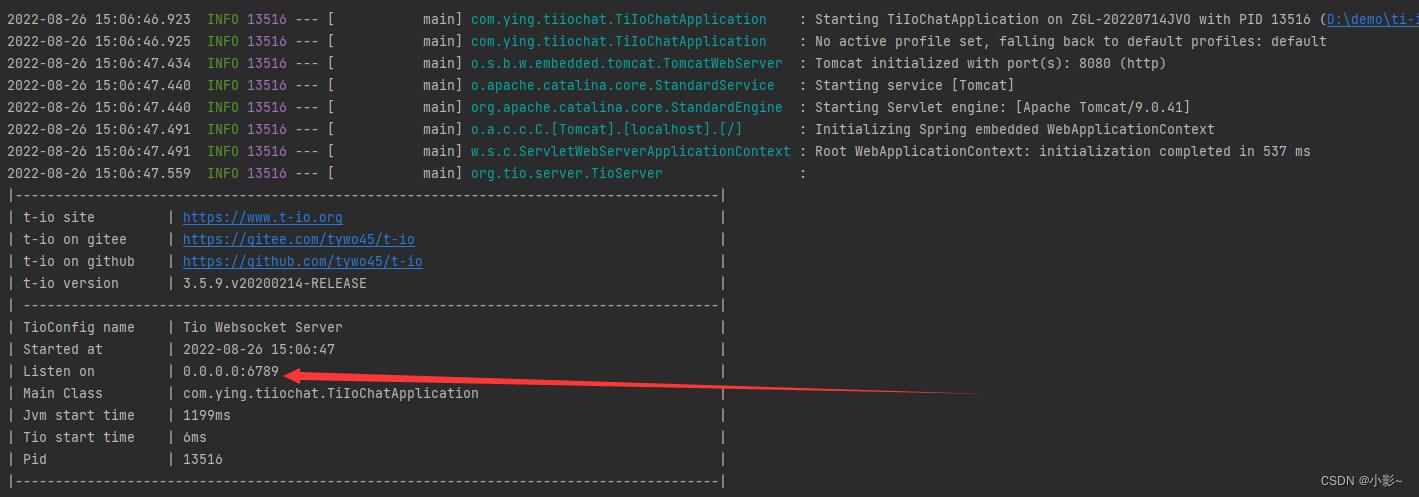
启动成功后,可以看出 tio 的打印结果,我们可以看出服务端口为我们设置的 6789,我们便可以连接测试了
前端代码(用脚写有点丑):
<!DOCTYPE html>
<html>
<head>
<meta charset="utf-8">
<title>websocket通讯</title>
</head>
<script src="https://cdn.bootcss.com/jquery/3.3.1/jquery.js"></script>
<script type="text/javascript">
<!-- 连接-->
var socket;
var userName;
// 连接
function connect()
var socketUrl = "ws://localhost:6789/?userId=" + $('#sendName').val();
if (socket != null)
socket.close();
socket = null;
socket = new WebSocket(socketUrl);
//打开事件
socket.onopen = function ()
console.log("开始建立链接....")
;
//关闭事件
socket.onclose = function ()
console.log("websocket已关闭");
;
//发生了错误事件
socket.onerror = function ()
console.log("websocket发生了错误");
;
/**
* 接收消息
* @param msg
*/
socket.onmessage = function (msg)
console.log(msg)
var json = JSON.parse(msg.data);
if (msg.msg != '连接成功')
$("#msgDiv").append('<p class="other" style="color:olivedrab;">' + json.sendName + ':'+json.msg+'</p>');
;
/**
* 发送消息
*/
function sendMessage()
var msg = $("#msg").val();
if (msg == '' || msg == null)
alert("消息内容不能为空");
return;
var receiver = $("#receiver").val();
if (receiver == '' || receiver == null)
alert("接收人不能为空");
return;
var sendName = $("#sendName").val();
if (sendName == '' || sendName == null)
alert("发送人不能为空");
return;
var msgObj =
"receiver": receiver,
"sendName": sendName,
"msg": msg
;
$("#msgDiv").append('<p class="user" style="color: red">' + sendName + ':'+msg+'</p>');
try
socket.send(JSON.stringify(msgObj));
$("#msg").val('');
catch (e)
alert("服务器内部错误");
</script>
<body>
用户名:<input type="text" id="sendName" value="李四">
<input type="button" value="连接" onclick="connect()" ><br>
发送者:<input type="text" id="sender" value="李四" ><br>
接受者:<input type="text" id="receiver" value="张三"><br><br>
消 息:<textarea id="msg"></textarea><br><input type="button" value="发送" onclick="sendMessage()"><br><br>
消息记录:<div id="msgDiv" style="border: 1px red solid;width: 400px;height: 200px"></div>
<br>
</body>
</html>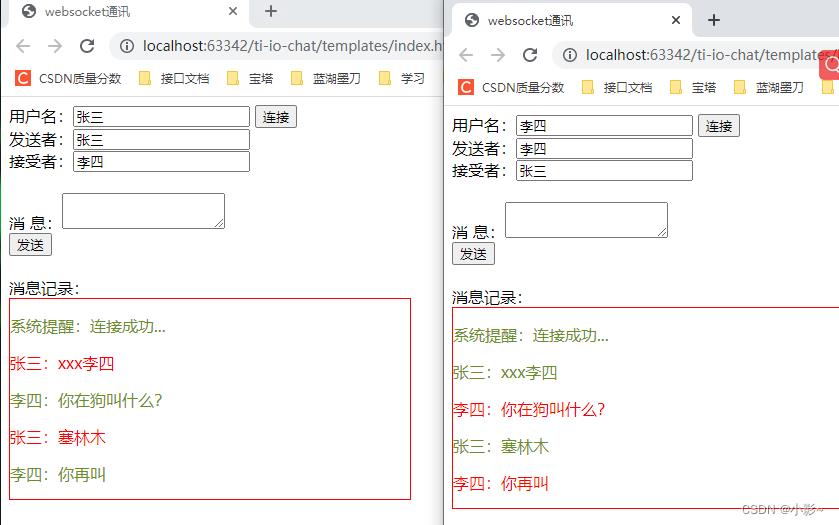
这是小编在开发学习使用和总结, 这中间或许也存在着不足,希望可以得到大家的理解和建议。如有侵权联系小编!
以上是关于Java实现在线聊天的主要内容,如果未能解决你的问题,请参考以下文章